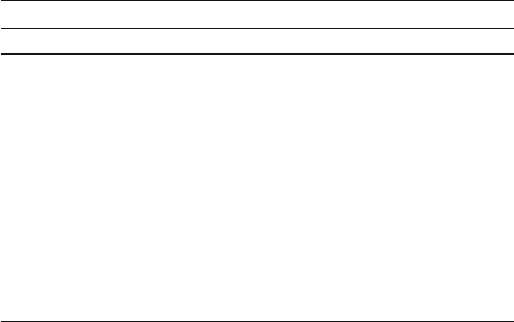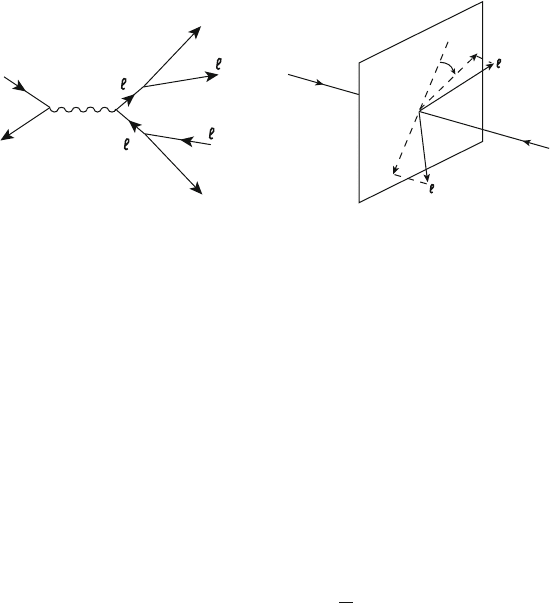Braibant S., Giacomelli G., Spurio M. Particles and Fundamental Interactions: An Introduction to Particle Physics
Подождите немного. Документ загружается.

392 13 Microcosm and Macrocosm
energy of baryons (940 MeV per baryon) dominates the total visible energy.
GUT theories are currently the only ones that easily explain the small n
B
=n
value.
13.2 Supersymmetry (SUSY)
The transformations seen thus far link particles of the same type; in general,
they “rotate” bosonic (or fermionic) states in other bosonic (or fermionic) states.
Supersymmetries transform (rotate) a bosonic state into a fermionic one and vice
versa. If these transformations exist, they would imply that bosons and fermions
are different manifestations of a unified state: fermions and bosons would be in
the same multiplet. These transformations are foreseen by supersymmetric theories
which represent a new form of unification. A supersymmetric operation changes by
1=2 the spin of particles, leaving the electric and color charges unchanged.
Supersymmetry has a cultural interest in itself; it also addresses some of
the difficulties of Grand Unified theories. Without supersymmetry, it is indeed
difficult to understand why the known fundamental particles are so light with
respect to the Grand Unification scale at 10
15
GeV. Supersymmetry solves this
hierarchy problem as well as the problem of divergences (for example, the radiative
corrections to the Higgs boson mass) [13L94]. In supergravity theories (SUGRA),
the supersymmetric concepts lead to the unification with gravity.
According to supersymmetry, every known boson has a fundamental fermionic
partner with spin differing by 1=2 unit, and any fundamental fermion has a bosonic
partner with spin differing by 1=2. The supersymmetric partners of the particles are
called sparticles. However, it seems impossible to connect the known fundamental
bosons and fermions. The sparticles must be new objects: they are expected to
be heavier than any known particle. This is a consequence of a supersymmetry
breaking: corresponding particles and sparticles should otherwise have the same
mass.
Supersymmetries postulate the existence of an operator U which transforms a
fermion into a boson by varying the spin by 1=2 unit, and vice versa:
U jfermioniDjbosoni
U jbosoniDjfermioni:
(13.6)
The boson-fermion symmetry implies the existence of doublets containing a
quark q and its supersymmetric partner, denoted as squark Qq (scalar quark), and
similarly for a lepton and the corresponding boson, the slepton
Q
l (scalar lepton):
q
Qq
;
l
Q
l
with spin
1=2
0
: (13.7)

13.2 Supersymmetry (SUSY) 393
Table 13.1 Fundamental particles and their supersymmetric partners. Only
the Higgs bosons of the MSSM are considered
Particle, R DC1 Sparticle, R D1
Particle Spin Charge Sparticle Spin S-name
e 1/2 1 Qe 0 selectron
1/2 1 Q 0smu
1/2 1 Q 0stau
1/2 0 Q 0 sneutrino
q 1/2 2=3; 1=3 Qq 0 squark
g 10 Qg 1/2 gluino
10 Q 1/2 photino
Z
0
10
Q
Z 1/2 zino
H
0
u
;H
0
d
00
Q
H
0
u
;
Q
H
0
d
1/2 neutral higgsino
H
C
u
;H
d
0
˙
1
Q
H
C
u
;
Q
H
d
1/2 charged higgsino
W
˙
1
˙
1
Q
W 1/2 wino
G 20
Q
G 3/2 gravitino
Sparticles couple with fields with the same coupling constant as the particles. For
example, the couplings qqg, Qq Qq Qg, ggg, Qg Qg Qg are always ˛
S
. Similarly, there exist
doublets for every vector boson and its supersymmetric partner, that is,
Q
;
Z
0
Q
Z
0
;
W
C
Q
W
C
;
W
Q
W
with spin
1
1=2
: (13.8)
The Higgs boson has spin S D 0; its supersymmetric partner has spin S D 1=2.
The notation for boson partners is as follows: starting from the ordinary name,
the suffix ino is added, that is, photon ! photino, Z
0
! zino, W
C
! wino, Higgs
! higgsino.
13.2.1 Minimal Standard Supersymmetric Model (MSSM)
Table 13.1 gives an overview of fundamental particles and their supersymmetric
partners. It refers to the Minimal Supersymmetric Standard Model (MSSM), the
simplest supersymmetric model (the only one we consider in the following). Also,
Table 13.2 refers to the MSSM. In this model, at least two complex doublets of
Higgs bosons
H
C
u
;
H
0
d
and
H
0
u
;
H
d
should be introduced to generate the masses of
“up” and “down” type quarks and the masses of the charged leptons. Supersym-
metric neutral states should mix as we saw in Chap. 12 for other systems. The
four neutral fermions Q;
Q
Z;
Q
H
0
u
;
Q
H
0
d
are not mass eigenstates; the latter are the
neutralinos Q
0
1
; Q
0
2
; Q
0
3
; Q
0
4
, expressed as a mixing of the type:
Q
0
1;2;3;4
D a Q Cb
Q
Z C c
Q
H
0
u
C d
Q
H
0
d
(13.9)

394 13 Microcosm and Macrocosm
Table 13.2 “Normal” fundamental particles and supersymmetric partners; right-handed particles
are included. The mass eigenstates resulting from the mixing between sparticles are also indicated
Quark Squark
(spin 1/2)
u
d
L
u
R
d
R
(spin 0)
Qu
Q
d
L
Qu
R
Q
d
R
c
s
L
c
R
s
R
Qc
Qs
L
Qc
R
Qs
R
t
b
L
t
R
b
R
Q
t
Q
b
L
Q
t
R
Q
b
R
!
Q
t
1;2
,
Q
b
1;2
Leptons Sleptons
(spin 1/2)
e
e
L
e
R
(spin 0)
Q
e
Qe
L
Qe
R
L
R
Q
Q
L
Q
R
L
R
Q
Q
L
Q
R
! Q
1;2
Gauge bosons Gauginos
(spin 1) g (spin 1/2) Qg
Q Neutralinos
Z
Q
Z !
0
1;2;3;4
W
˙
Q
W
˙
fQ;
Q
Z;
Q
H
0
u
;
Q
H
0
d
g
Higgs bosons Higgsinos Charginos
(spin 0) h
0
;H
0
;A
0
(spin 1/2)
Q
H
0
u
;
Q
H
0
d
!
˙
1;2
H
C
;H
Q
H
C
u
;
Q
H
d
f
Q
W
˙
;
Q
H
˙
g
with different coefficients for Q
0
1
, Q
0
2
, Q
0
3
, Q
0
4
. Similarly, the two charged Higgsinos
Q
H
C
u
,
Q
H
d
and the two winos
Q
W
C
,
Q
W
are not mass eigenstates; the mass eigenstates
are the charginos Q
C
and Q
expressed as mixings of the type:
Q
C
D a
0
Q
W
C
C b
0
Q
H
C
u
; Q
D a
00
Q
W
C b
00
Q
H
d
: (13.10)
Since no sparticle has been experimentally observed, a new quantum number,
the R-parity, is introduced in order to provide the supersymmetric particles with
some properties that make them (currently) inaccessible. R-parity is equal to
R D .1/
3BCLC2S
,whereB is the baryon number, L the lepton number, and S
the spin. Most SUSY models require the conservation of R andthenpredictthe
existence of a stable supersymmetric particle with a minimum mass (the “Lightest
Supersymmetric Particle,” LSP). There are other models where R can be violated.
In the MSSM, R-parity is conserved; R DC1 is assigned to known particles and
R D1 to the supersymmetric partners, that is,
Rjsupersymmetric particleiDjsupersymmetric particlei
RjparticleiDCjparticlei:
The general situation can be more complex, as the right-handed states, such as, e
R
,
q
R
, could give sparticles different from the left-handed ones, as shown in Table 13.2.

13.2 Supersymmetry (SUSY) 395
~
WW W
~
W
~
+
+
+
+
+
γ
~
γ
γ
q
q
~
e
L
~
ν
L
~
ν
L
~
q
q
q
~
e
L
~
q
W
e
L
e
L
e
L
γ
ν
L
ν
L
ν
L
q
q
a
b
Fig. 13.4 (a) Fundamental Feynman diagrams in the SM and (b) with the introduction of
supersymmetric partners. Antiparticles are not indicated. Here L (Left) represents the particle
helicity
13.2.1.1 The Higgs Sector of the MSSM
In the MSSM, two complex doublets of Higgs bosons provide eight degrees of
freedom. Three degrees of freedom are used to give mass to the W
C
;W
;Z
0
.
The Higgs sector in the MSSM contains five bosons (and their supersymmetric
partners) that correspond to the remaining five degrees of freedom. The Higgs
bosons have been called h
0
;H
0
;H
C
;H
with even CP and A
0
with odd CP .
With m
h
0 <m
H
0 <m
H
˙
,theh
0
boson can be identified with the scalar Higgs
boson H
0
of the Standard Model, introduced in Chap. 11.
In summary, one can observe from Table 13.2 that in the MSSM:
1. The number of particles doubles.
2. The supersymmetric partner of known gauge bosons corresponds to the
gauginos.
3. Three sfermion families correspond to the three fermion families.
4. In the Higgs sector, there are two doublets leading to five Higgs bosons and five
Higgsinos.
13.2.1.2 Fenomenology
Calculations in the MSSM use the same Feynman rules of the Standard Model,
adding the contribution of diagrams in which particles are replaced by their super-
partners. The substitution of particles with sparticles must be made in pairs for an-
gular momentum conservation. Boson-fermion couplings are illustrated in Fig. 13.4.
Since in the MSSM model the R-parity is a conserved quantum number, all
vertices include superpartner pairs. Three conclusions can be drawn:
1. The supersymmetric partners are produced in pairs from normal particles.
2. There is always a supersymmetric particle in the decay products of a supersym-
metric particle.
3. The lightest supersymmetric particle (LSP) is stable; it is usually assumed that
the LSP is the neutralino Q
0
1
which is neutral both for electric and color charges;

396 13 Microcosm and Macrocosm
e
+
e
–
γ, Z
0
∼
∼
−
−
+
+
χ
∼
0
χ
0
∼
e
+
e
–
θ
–
+
a
b
Fig. 13.5 (a) Feynman diagram for the slepton–antislepton pair production followed by the
slepton decay:
Q
`
! `
Q
0
and
Q
`
C
! `
C
Q
0
.` D e; ;/.For` D e, the diagram where
a Q
0
1
is exchanged in the t-channel also contributes. (b)Sketchofaneventwhichproducesan
acoplanar slepton–antislepton pair. The acoplanarity angle is the angle between the projections
of the `
and `
C
momenta in the plane perpendicular to the e
C
and e
beams
the neutralino could therefore be an important component of dark matter in
the Universe (see Sect. 13.6). For special mixing conditions, the LSP could
correspond to the sneutrino.
Supersymmetry is not visible in nature and therefore must be “broken,” at
least at the currently accessible energies. As the Standard Model, supersymmetric
theories cannot predict the values of the particle masses, but once they have
been experimentally determined, one can calculate all other quantities. Recent
phenomenological supersymmetric models predict supersymmetric particles with
masses between 100 and 1,000GeV; these are searched for at the LHC.
Many searches for supersymmetric particles at
pp, ep, e
C
e
colliders have been
carried out, up to now with negative results; only lower limits on their mass were
determined. These limits (at the 95% confidence level) are presented in Table 13.3.
With the introduction of supersymmetry, the extrapolation of the interaction
coupling constants to 10
15
GeV have better behavior: the three constants appear to
converge towards a common point, as shown in Fig. 13.1b.
13.2.1.3 Searches for Charged Sleptons
Let us briefly discuss an example of a typical SUSY particle search. Figure 13.5a
shows the Feynman diagram for the production of charged scalar leptons e
C
e
!
; Z
0
!Qe
C
Qe
; !Q
C
Q
.
The sleptons decay in the corresponding charged leptons plus a neutralino,
Q
`
˙
!
`
˙
Q
0
;the Q
0
(subject only to weak interaction) leaves the detector unobserved. The
topology of the signal events (Fig. 13.5b) consists of two acollinear and acoplanar
charged leptons, plus missing energy and momentum. The sleptons
Q
`
R
and
Q
`
L
are
different particles with different masses. The most stringent experimental limits
13.3 Composite Models 397
generally apply to
Q
`
R
, whose mass is expected to be smaller than that of
Q
`
L
.
There may also be special conditions in the MSSM parameters space for which
m
Q
`
L
D m
Q
`
R
.
13.2.2 Supergravity (SUGRA). Superstrings
GUT theories, including normal supersymmetric theories, do not incorporate the
gravitational interaction. Gravitation becomes important for energies of the order
of the Planck mass, 10
19
GeV, corresponding to a size of 10
33
cm. Such energies
existed in the early Universe until the Planck time, 10
43
s.
A complete theory must contain quantum gravity. Its inclusion presents important
difficulties, connected both to the quantization and to divergences. The latter cannot
be easily removedby renormalization procedures, as in the supersymmetric theories.
The supersymmetric theory of gravity, called quantum supergravity or SUGRA,
has local gauge invariance. In some models, the lightest supersymmetric particle is
assumed to be the gravitino.
Finally, theories in which the particles are very small size objects, for example,
strings, in particular closed strings, have been formulated. These theories succeeded
in incorporating quantum gravity. The string theories concern both bosonic states
and supersymmetric theories (superstrings theories). They should be formulated in
a space with many dimensions (at least ten); it is not obvious how to switch to the
four dimensions of the ordinary space (the other six dimensions must be “hidden”)
[13G00].
13.3 Composite Models
The existence of three families of quarks and leptons suggests the existence of
possible substructures in quarks and leptons. The situation could be similar to
that already encountered with atoms, nuclei and hadrons. There are other reasons
to consider substructures. In some models quarks, leptons and gauge bosons are
composite objects. For example, in the model of Salam and Pati, quarks and leptons
are composed of three objects called prequark or preons; in the model of Harari,
they are composed of three objects called rishons, which means “fundamental”
in Hebrew. There are several difficulties in these theories associated with the very
small dimensions of prequarks (much less 10
16
cm, also their orbits must be less
than 10
16
cm) and with the need for an additional force that binds the prequarks.
In another model, prequarks are dions, namely, particles with both electric and
magnetic charges; in other models, the prequarks are so close together that the
gravitational force is also involved.

398 13 Microcosm and Macrocosm
Table 13.3 Searches for new particles. Lower mass limits in GeV [P10, 13w1,
13w2] at the 95% confidence level obtained in searches at LEP and other high-
energy colliders (Tevatron and HERA). The LEP limits are obtained by combining
the results of the four LEP experiments. If the combination does not exist, we refer
to the best limit from a single experiment
Particle Symbol LEP limit (GeV) Other limits (GeV)
Charged sleptons
a
Qe, Q, Q 99:9; 94:9; 86:6
Sneutrino Q 94 (DELPHI)
Neutralino (LSP) Q
0
50.3
Charginos Q
˙
103.5 117 (D0)
Scalar quarks
Q
b,
Q
t 99, 98 222, 176 (D0)
Gluinos Qg 26.9
b
308 (D0)
SM Higgs H
0
SM
114:4
MSSM Higgs h
0
92:8 100 (CDF)
A
0
93:4 100 (CDF)
H
˙
78:6
Higgs (charge D 2) H
˙˙
99 (OPAL) 136 (CDF)
Exited leptons e
;
;
208; 190; 185 (OPAL) 255 (H1), 221 (CDF)
Exited neutrinos
190 (L3) 158 (ZEUS)
Exited quarks q
200 775 (D0)
Scalar leptoquarks
c
LQ 98 (OPAL) 229 (D0)
Vector leptoquarks
c
LQ 98 (OPAL) 240 (D0)
a
For supersymmetric particles, the limits are usually obtained within the MSSM;
in some cases, the limits are within a specific model
b
Limit for a light gluino (stable)
c
Associated pair production
Several searches for particle substructures or excited states have been carried
out, all with negative results so far. The lower limits on their masses are presented
in Table 13.3.
Excited leptons. They would correspond to excited states of known leptons that
could be produced in pairs or individually: e
C
e
! e
C
e
, e
C
e
! e
C
e
.
Exited leptons could decay electromagnetically,
e
! e;
! ;
! ; (13.11)
without violating the three lepton numbers. These decays were not observed at a
sensitivity level of about 10
4
.
Decays with violation of lepton numbers. Quarks and leptons of the second and
third family can be thought of as excited states of quarks and leptons of the first
family. In this case, decays of the type
! e; ! e; ! eee (13.12)

13.3 Composite Models 399
could be possible and the electron and muon, or electron and tau leptonic numbers
are violated. These decays were not observed, resulting in the following stringent
upper limit [13M10]:
.! e/
.! e/
< 310
11
: (13.13)
The could also decay in , ! , violating the muon and tau leptonic
numbers (also this decay channel has never been observed).
Excited neutrinos could be the weak isospin partners of excited charged leptons.
They could be produced in pairs or individually and could then decay with the
emission of a photon: e
C
e
!
! , e
C
e
!
! .
Excited quarks. An excited quark could decay into a quark and a photon, q
! q,
or a quark and a gluon, q
! qg; the relative frequency should be approximately
1–10. In the first case, q
! q, an isolated high energy photon would be present
in the final state. In e
C
e
collisions, events with one or more high energy photons
could come from excited quarks, but also from the bremsstrahlung of a beam e
(or
e
C
) or from the bremsstrahlung from a q.q/ in the final state.
Leptoquarks. Leptons and quarks are classified in a similar way with respect to
the family structures and weak isospin multiplets. The Standard Model does not
explain this parallelism, although it is necessary for the cancellation of divergent
terms. This suggests that there could be a deeper correlation between quarks and
leptons. In models that go beyond the SM, new particles that mediate the interaction
between quarks and leptons may exist. This occurs naturally in GUT models, at very
high energies. In some SM extensions, the existence of leptoquark bosons .LQ/
are foreseen. LQ are color triplets with both lepton and baryon number, electric
charge 1=3, 2=3 and relatively low masses. These LQs decay and couple with
a lepton and a quark. According to various models, LQs are scalar (spin D0) or
vector (spin D1) particles, and their coupling with leptons and quarks depends on
the model. LQs were introduced for the first time [13P74] in an attempt to consider
the lepton number as a fourth color. In the simplest model, the interactions involving
LQs conserve baryon and lepton numbers and respect the symmetry of the Standard
Model. In this case, the only free parameters are the LQ masses and their couplings
with the fermions.
LQs produced in pairs have been searched for in e
C
e
collisions, as shown in
Fig. 13.6a:
e
C
C e
! LQ C LQ; LQ ! ` C q; LQ ! ` C q: (13.14)
In this case, the LQ decay modes into eq, q, q were used. These combinations
should conserve the “family number,” i.e., the pairs must involve ` and q only of the
same family.

400 13 Microcosm and Macrocosm
e
+
e
–
q
q
LQ
LQ
γ, Z
e
+
e
+
e
+
e
+
e
+
e
–
e
–
e
–
e
–
e
–
e
–
q
q
LQ
γ,Z
q
q
q
q
q
LQ
LQ, q
γ
~
abcd
Fig. 13.6 Feynman diagrams for leptoquark production and decay in e
C
e
collisions. The
leptoquark can be produced (a) in pairs (any LQ type) (b)and(c) individually (in this case, the
leptoquarks belong to the first family and only couple with charged leptons). (d) Indirect effects
due to the (virtual) exchange of a leptoquark of the first family in the t-channel
d
u
LQ
e
–
e
–
d
u
u
p
u
LQ
e
+
e
+
d
d
u
u
up
u
ab
Fig. 13.7 Feynman diagrams for leptoquarks of the first family produced in ep collisions: (a) LQ
formation, (b) LQ exchange in the t-channel
Individually produced LQs were also searched for in (see Fig. 13.6b,c):
e
C
C e
! e
C
C q CLQ ! e
C
C e
C q Cq (13.15)
as well as indirect effects due to the exchange of a leptoquark of the first family
in the t-channel (Fig. 13.6d). Electron–positron (ep) collisions, as in the HERA
collider (Chap. 10), offer an easier way to search for leptoquarks of the first family
(Fig. 13.7), that is,
e Cp ! LQ C q Cq ! e
C
C d Cq C q: (13.16)
In this case, a resonant system (eq) with an enhanced cross-section could be formed.
The events should have a high energy lepton, a jet of hadrons at large angles and a
“spectator jet” in the final state. Events are therefore similar to those of a typical
deep inelastic collision.
13.4 Particles, Astrophysics and Cosmology
Cosmology has recently acquired the characteristics of an experimental discipline
[13W07]. Particles with their fundamental interactions, astrophysics and cosmology

13.4 Particles, Astrophysics and Cosmology 401
have become closely related fields. The submicroscopic phenomena allow us to
better understand the evolution of the Universe and astrophysics, and vice versa.
For example:
• The understanding of atomic and molecular phenomena clarified the light
spectrum emitted by the Sun (and more generally by the stars), the chemical
composition of the solar atmosphere and led to the discovery of helium.
• The knowledge of nuclear phenomena explain the energy source of the Sun and
of the stars. At the center of a star there is a “furnace” where nuclear fusion
reactions take place (Sect. 14.10).
• Nuclear and subnuclear physics allow us to understand the structure of particular
celestial bodies in extreme conditions, for example, white dwarfs, neutron stars
and stellar gravitational collapses (Problem 13.6).
A deep connection exists between cosmic rays and subnuclear physics [G90].
Primary cosmic rays mainly consist of high energy protons and atomic nuclei which,
coming from outside of the solar system, interact with the nuclei of the Earth’s
atmosphere. In an interaction, many particles (some of them unstable) are produced
(secondary cosmic rays). The understanding of the origin of cosmic rays, their
acceleration mechanisms, the interaction processes with interstellar material and the
Earth’s atmosphere is based on the knowledge of nuclear and subnuclear physics.
However, the reverse is also true: many particles were discovered in secondary
cosmic rays.
Particle and astrophysics: the example of neutrino telescopes [13C10].
Astrophysics has experienced an extraordinary development in recent
decades thanks to new techniques that allowed the transition from limited
observations of the visible band of the electromagnetic spectrum to other
wavelengths: from the radio and infrared waves on one side, to X -rays
and -rays on the high energy side. The information that these observations
can provide to the mechanisms that take place in astrophysical objects such
as supernova remnants (SNR), pulsars (PLS), active galactic nuclei (AGN)
and others is unfortunately incomplete, as it is limited to electromagnetic
processes. Cosmic particle accelerators (in the galaxy and outside our
galaxy) capable of accelerating protons and nuclei as observed in the cosmic
rays (CR) must therefore exist .
The CR spectrum extends with amazing regularity up to 10
20
eV, with a
power law of the form d˚=dE ' E
, with D 2:7 for energies up to
10
15
eV. This behavior can be explained by the so-called “Fermi mechanism”
acceleration process. Accelerated protons and nuclei (hadronic processes)
may interact with ambient nuclei or with the gas of photons giving rise to
and K mesons. The
0
(with very short lifetime) produces a photon pair,
the
˙
decay in charged leptons, neutrinos and antineutrinos (Problem13.1).
It is not an easy task to distinguish the photons produced in hadronic
processes from those produced in purely electromagnetic processes (by high
